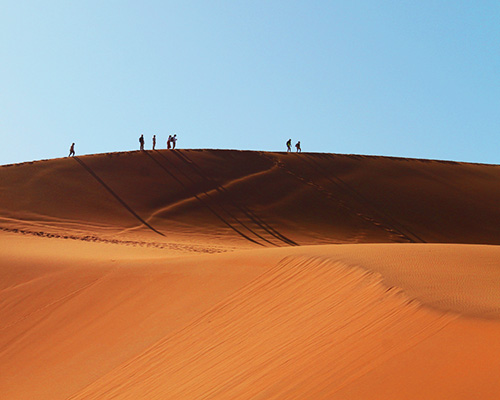Big Daddy Namib-Naukluft Park Namibia
Big Daddy Dune Namibia
Big Daddy Dune: The Towering Giant of Sossusvlei

Rising majestically from the red sands of Namibia's Namib Desert, Big Daddy stands as the tallest dune in the Sossusvlei area, and one of the highest sand dunes in the world. With a height of approximately 325 meters (1,200 feet), Big Daddy offers not only a physical challenge for adventurers, but also a breathtaking reward—panoramic views of a surreal desert landscape that feels more like a dreamscape than reality.
Big Daddy is located in Sossusvlei, a salt and clay pan surrounded by towering dunes within the Namib-Naukluft National Park. The Namib Desert, often regarded as the oldest desert on Earth, stretches along Namibia’s Atlantic coast and is home to some of the most iconic and photogenic landscapes on the continent. What makes Big Daddy particularly special is its proximity to Deadvlei, a white clay pan dotted with 900-year-old camelthorn trees. From the top of the dune, hikers can gaze down on Deadvlei’s stark, cracked surface and twisted blackened trees, creating a contrast that is as haunting as it is beautiful.
A Climb Worth the Effort. Climbing Big Daddy is no easy feat. The fine, loose sand and steep incline demand stamina, determination, and a good pair of shoes. The best time to start the hike is at sunrise, when the desert air is still cool and the soft golden light bathes the dunes in hues of orange and pink. The climb can take anywhere from 45 minutes to 1.5 hours, depending on your pace and fitness level. Every step upward is a small victory, as feet sink into the sand and the ridge narrows. Yet, the higher you climb, the more surreal the views become—waves of red dunes roll endlessly across the desert, and the ever-changing shadows and light make the landscape seem alive. Reaching the summit is a moment of triumph, but the real fun begins with the descent. Many visitors choose to run or slide down the steep slipface toward Deadvlei, an exhilarating experience that feels like skiing on sand.
Geological and Natural Marvel. The Namib Desert is a place of geological wonder, and Big Daddy is a prime example of nature’s artistry. The sand that forms these dunes is thought to be over five million years old, carried by wind from the interior of southern Africa and sculpted into sinuous ridges by the desert’s fierce breezes. The color of the dunes ranges from bright orange to deep red, a result of iron oxide and the age of the sand—older dunes have richer colors.Despite its arid environment, the area supports a surprising variety of life. Small creatures like beetles, lizards, and geckos have adapted to the harsh climate, while occasional oryx and springbok can be seen traversing the open plains.
Visiting Big Daddy. To reach Big Daddy, visitors typically drive into Sossusvlei with a 4x4 vehicle. The last stretch, beyond the 2WD parking area, is accessible only via soft sand tracks. There are also shuttle services available for those without off-road driving experience. The region is best visited in the cooler months from May to September, when daytime temperatures are more manageable and skies are clear. Lodging options range from campsites and rustic desert lodges to luxury accommodations nearby, all offering a gateway to explore this otherworldly terrain.
A Bucket List Destination. Climbing Big Daddy is more than just a hike—it’s a journey into the soul of one of the world’s oldest deserts. It’s about witnessing the raw beauty of nature, feeling the silence of the sand, and standing atop a dune that has stood for millennia. Whether you're a photographer, an adventurer, or simply a curious traveler, Big Daddy delivers an unforgettable experience in the heart of Namibia’s stunning Sossusvlei.
Please contact us to plan your dream safari to Namibia!
Other interesting articles about Namibia
